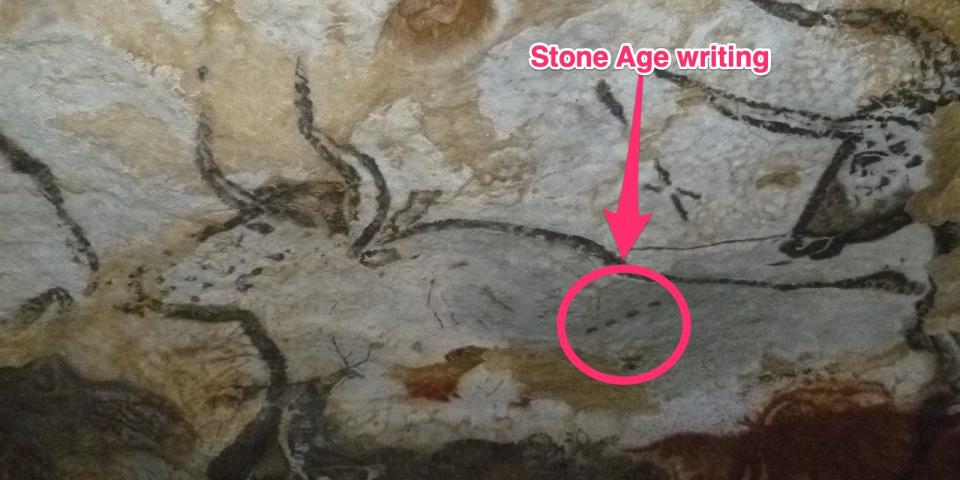Art
Amateur archaeology sleuth deciphers messages hidden in Stone Age cave art for 25,000 years
|
|

An amateur archaeologist has decoded what experts describe as “the first known writing in the history of Homo sapiens,” according to a paper published in the Cambridge Archaeological Journal.
Ben Bacon, a furniture restorer by day, spent his nights analyzing photographs of cave paintings, according to The Times. His hobby led to the “first specific reading of European Upper Palaeolithic communication,” the journal article reads.
The code inscriptions that Bacon, 67, decoded appear in at least 400 caves across Europe which are up to 25,000 years.
The writing was discovered approximately 150 years ago but has perplexed scientists ever since.
However, Bacon deduced that paleolithic hunter-gatherers would store data about the animals they needed to kill to survive in the cave drawings of bulls, horses, aurochs, and stags, using codes to detail their breeding cycle based on the lunar cycle beginning in spring.
For example, a line or a dot would mean months, so four dots or lines would represent the fourth month after the start of spring. Then, a symbol resembling the letter Y was used to mean “to give birth,” the journal article says, and the position of the Y amongst the dots or lines would indicate a due date.
Sharing knowledge of their preys’ breeding season would have been important information for the Stone Age hunters because it meant that large herds of animals could be forming, said Professor Paul Pettitt of Durham, per The Times.
Bacon told The Times that he believed this discovery had the power to change our understanding of Stone Age communities.
“They’ve conventionally been thought of as superstitious people who try to use hunting magic to kill animals,” he told the newspaper, adding, “The signs are actually a scientific observational database of information that they build up over many years and sometimes decades.”
Read the original article on Business Insider





Art
Art in Bloom returns – CTV News Winnipeg
Art
Crafting the Painterly Art Style in Eternal Strands – IGN First – IGN
Next up in our IGN First coverage of Eternal Strands, we’re diving into the unique and colorful art in the land of the Enclave. We sat down with art director Sebastien Primeau and lead character artist Stephanie Chafe to ask them all about it.
IGN: Let’s talk about Eternal Strands’ distinctive art style. What were some of the guiding principles behind the art direction?
Primeau: I think what was guiding the art direction at the beginning of the project was to find the scale of the game, because we knew that we were having those gigantic 25-meter tall creatures and monsters. So we really wanted to have the architectural elements of the game – the vegetation, the trees – to reflect that kind of size.
So one of my inspirations was coming from an architect called Hugh Ferriss, and I was very impressed by his work, and it was very inspiring for me too. So just the scale of his work. So he was a real influence for Metropolis, Gotham, so I was really inspired by his work.
Chafe: I think one of the things that, just as artists and as creators, we were interested in as well was going for a color palette that can be very bright. And something that can really challenge us too as artists, and going into a bit more of at-hand painterly work, and getting our hands really into it, into the clay, so to speak, and trying to go for something bright and colorful.
IGN: That’s not the first time I’ve heard your team describe the art style as “painterly.” What does that mean?
Primeau: Painterly is just a word that can give so much room to different types of interpretation. I think where we started was Impressionist painters. So I really enjoy looking at many painters, and they have different types of styles. But we wanted to have something that was fresh, colorful, and unique.
And also, I remember when we were starting the project there was that word. “It’s going to be stylized,” but stylized is just a word that gives so much room to different kinds of style. And since we were a small team, we had to figure out a way to create those rough brushstrokes. If it was painted very quickly by an artist, like Bob Ross would say, “Accident is normal.” So I think we wanted to embrace that. And because we’re all artists, it’s hard too, at some point, to disconnect from what you’re doing. It’s like, “Oh, I can maybe add some more details over there.” But I was always the- “Guys, oh, Steph, that’s enough. Let’s stop it right there. I think it looks cool.”
IGN: So, when you create an asset for Eternal Strands, is somebody actually painting something?
Chafe: I can speak more on the character side. For us, we do a lot of that hand painting, a lot of those strokes by hand. And we try to embrace, not the mistakes, but the non-realistic part of it having an extra splotch here and there.
We’ve got brushes that we made that can help us as artists to get the texture we’re looking for. It really is a texture that gives to it. But a lot of the time it’s not just something generated in a substance painter, or getting these things that will layer these things for you, making it quick and procedural. Sometimes we have those as helpers, but more often than not we just go in and paint.
IGN: Eternal Strands is a fair bit more colorful than lots of games today. Why was it important to the team to have lots of bright colors?
Primeau: You need to be careful, actually, with colors. Because with too many colors you can create that kind of pizza of color.
We wanted to balance the color per level, because we’re not making an open-world game. I really wanted each level to have their own color palette identity. So we’re playing a lot with the lighting. The lighting for me is key. It’s very important. You can have gorgeous textures, props, characters, but if your lighting is not that great, it’s like… So lighting is key. And especially with Unreal Five, we have now, access to Lumen. It brought so much richness to the color, how the color is balancing with the entirety of the level. It definitely changed the way we were looking at the game.
We’re using the technology, but in a way to create something that feels like if you were looking at a painting. I think we have achieved that goal.
Chafe: I’m very happy with it.
IGN: What were your inspirations from other games or other media when developing the art style?
Primeau: I have many. I’ll start with graphic novels, European graphic novels. I really wanted to stay away from DC comics, Marvels comics, those kinds of classics.
Before I started Eternal Strand, I saw a video. It was one of the League of Legends short films for a competition. It’s “RISE.” I don’t know if you remember that one, but it was made by Fortiche Studio who did Arcane, and I’m a huge fan of Arcane. When I saw that short film, it was way before Arcane was announced, I was like, “oh gosh, this is freaking cool. This is so amazing. I wish I would be able to work on a game that has that kind of look.”
Chafe: For me, when we started the project, one of the things that I wanted to challenge myself a lot was in concept and drawing and stuff like that and doing more, learning more about color as well, which is something I find super fascinating and also kicks my butt all the time because of just color theory in general.
But with the [character] portraits specifically, I think, I mean, growing up I played a lot of games, a lot of JRPGs too. I played just seeing basic portraits in something like Golden Sun or eventually also Persona and of course Hades, which is a fantastic game. I played way too much of that, early access included. But I really liked that part. Visual novels too, just that kind of thing. You can get an emotion from a 2D image as well when it’s well done, especially if you have voices on top of it.
IGN: Were there any really influential pieces of concept art that served as a guiding document the team would reference later on?
Chafe: I have one personal: It’s really Maxime Desmettre’s stuff because it was so saturated. Blue, blue, blue sky. Maxim Desmettre is our concept artist that we have who works from Korea. When I joined the project, seeing that was just like… and seeing that as a challenge too, like ‘how are we going to get there?’
The one that I’m thinking of that hopefully we could find after, just in general with the work that always speaks so much to me is this blue, blue sky and the saturation of the grass. But also when he gets into his architecture and stuff like that, there’s just a warmth to everything. The warmth to the stone that just makes it look inviting and mysterious at the same time. And I think that really speaks a lot to it.
IGN: How did you go about designing Eternal Strand’s protagonist: Brynn?
Primeau: I think that Mike also, when he pitched me the character, he was using Indiana Jones as an example. So courageous, adventurer guy, cool guy. Also, when you’re looking at Indiana Jones, he’s a cool guy. And we wanted to create that kind of coolness also out of our main protagonist. And I remember it took time. We did many iterations.
Chafe: It was a lot of iterations for sure. Well, I think I had done a bunch of sketches because it’s what’s going to be the face of the player, and also to have her own personality as well in the story, and her history as well. And the mantle was a really big one too. What gives her one of sets of her powers and stuff, figuring that out was actually one of the longest processes. It’s just a cape, but at the same time, it’s getting that to work with gameplay and all that kind of stuff. But yeah, all of Brynn’s personality and her vibe really comes from a lot of good work from the narrative team. So, mostly collaboration there.
IGN: What’s the deal with Brynn’s mentor: Oria? How did you settle on a giant bird?
Chafe: Populating the world of the enclave was, “it’s free real estate.” You get to just throw things on the wall and see what sticks. And, “Oh, that’s really cool. Oh, that’s nice.” At some point I’d done a big sketch of a big bird lady with a claymore, and Seb said, “That’s cool.” And then kind of ran with it.
IGN: What’s the toughest part about the art style you’ve chosen for Eternal Strands?
Primeau: The toughest part was…A lot of people in the team have experience making games, so it was to get outside of that mold that we’ve been to.
For me, working on games that were more realistic in terms of look, I think it was really tough just to think differently, to change our mindset, especially that we knew that we would be a small team, so we had to do the art differently, find recipes, especially when we were talking about textures, for example. So having a good mix.
Chafe: One of the things too is also as we’re all a bunch of artists, and every artist has their own style that they just suddenly have ingrained in them, and that’s what makes us all unique as artists as well. But when you’re on a project, you have to coalesce together. You can’t kind of have one look different from the other. When you’re doing something more realistic, you have your North Star, which is a giant load of references that are real. And you can say “it has to look like that, as close to that as possible.”
When you have a style in mind and you’re developing at the same time, you kind of look at it and you review it and you have a feeling more than anything else.
You’re training each other with your styles as you kind of merge together in the end. And that kind of is how the style happened through, like you mentioned, like finding easy recipes, through just actually creating assets and seeing what comes out and, “Oh, that’s really cool. Okay, we can now use that as kind of our North Star.”
For more on Eternal Strands, check out our preview of the Ark of the Forge boss fight, or read our interview with the founders of Yellow Brick Games on going from AAA studios to their own indie shop, and for everything else stick with IGN.
Art
Collection of First Nations art stolen from Gordon Head home – Times Colonist


Saanich police are investigating the theft of a large collection of First Nations art valued at more than $60,000 from a Gordon Head home.
The theft happened on April 2.
The collection includes several pieces by Whitehorse-based artist Calvin Morberg, as well as Inuit carvings estimated to be more than 60 years old.
Anyone with information on the thef is asked to call Saanich police at 250-472-4321.
jbell@timescolonist.com
-



 Science11 hours ago
Science11 hours agoJeremy Hansen – The Canadian Encyclopedia
-



 Tech10 hours ago
Tech10 hours agoSave $700 Off This 4K Projector at Amazon While You Still Can – CNET
-



 Investment11 hours ago
Investment11 hours agoUK Mulls New Curbs on Outbound Investment Over Security Risks – BNN Bloomberg
-



 Tech9 hours ago
Tech9 hours ago'Kingdom Come: Deliverance II' Revealed In Epic New Trailer And It Looks Incredible – Forbes
-



 Sports9 hours ago
Sports9 hours agoAuston Matthews denied 70th goal as depleted Leafs lose last regular-season game – Toronto Sun
-
Business8 hours ago
BC short-term rental rules take effect May 1 – CityNews Vancouver
-
Real eState10 hours ago
Sick of Your Blue State? These Real Estate Agents Have Just the Place for You. – The New York Times
-



 Investment8 hours ago
Investment8 hours agoBenjamin Bergen: Why would anyone invest in Canada now? – National Post




